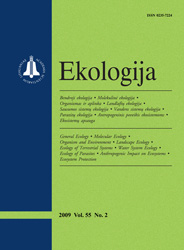 ISSN 0235-7224 ISSN 2029-0586 (online) |
2008 m. Nr. 3 Possibility of micromycetes detected in dust to grow on metals (Al, Fe, Cu, Zn) and on polyaniline-modified Ni
Studies performed in 2006–2007 have shown that dust particles present in the air of industrial and residential premises are constant pollutants of the environment. By their origin, they can be separated into technical (anthropogenic) and natural. Technical sources of dust are closely related to the character of the industrial operations, as well as on the chemical and physical properties of the raw materials used. Dust contains a great number of microorganisms; it makes a peculiar environment for microorganisms to survive and gives an impulse to begin developing under unfavourable conditions and to become active components of the ecological environment. So microorganisms find their way onto metals, attach to their surface and start to act forming chemical bonds, thus chemical processes set in. The surface of metals starts to exchange. The data obtained have shown that under conditions of natural environment, most of micromycete cosmopolites belonging to Penicillium, Aspergillus, Alternaria, Ulacladium, Fusarium, Scopulariopsis, Paecilomyces, Rhizomucor, Rhizopus, Botrytis, Cladosporium, Chrysosporium and more rarely to other genera can attach to metal surface. The strength of bonds and the course of attachment between various species of fungi and metals differ. Purposeful studies carried out with individual strains of micromycetes will help create methods to decelerate the corrosion of Al and other metals and to diminish the environmental impact on metal surfaces, thus preventing substantial economic losses. Keywords: dust, micromycetes, metals, corrosion, polyaniline film, environment, protection |
Issues:
2011 - Vol.57 No. 1, No. 2 2010 - Vol.56 No. 1-2, No. 3-4 2009 - Vol.55 No. 1, No. 2, No. 3-4 2008 - Vol.54 No. 1, No. 2, No. 3, No. 4 2007 - Vol.53 No. 1, No. 2, No. 2.priedas, No. 3, No. 4 2006 No. 1, No. 2, No. 3, No. 4 2005 No. 1, No. 2, No. 3, No. 4 2004 No. 1, No. 2, No. 3, No. 4 2003 No. 1, No. 2, No. 3, No. 4 2002 No. 1, No. 2, No. 3, No. 4 2001 No. 1, No. 2, No. 3, No. 4 |